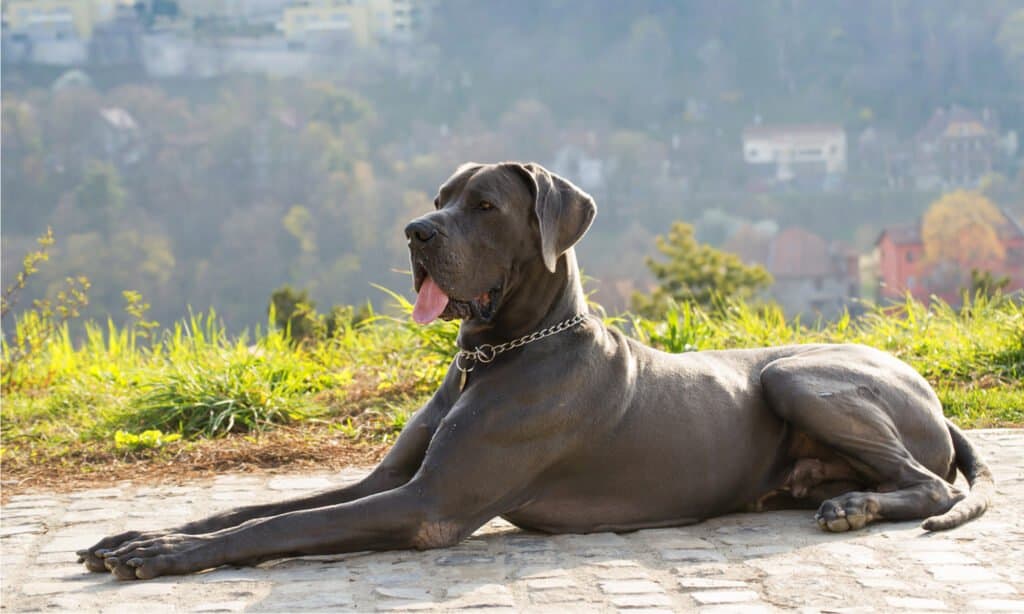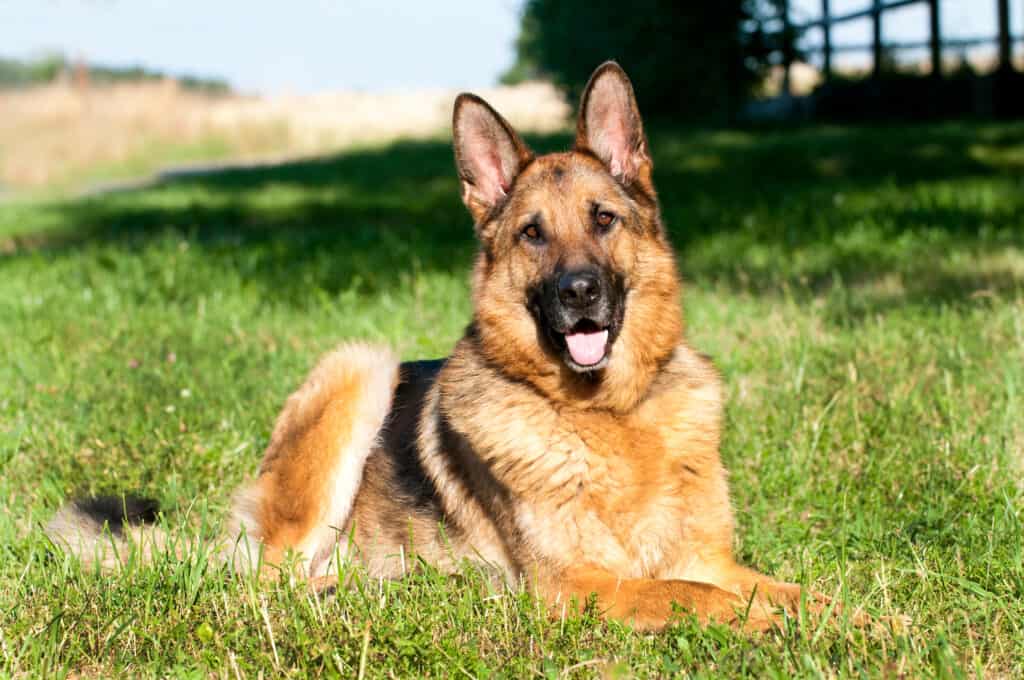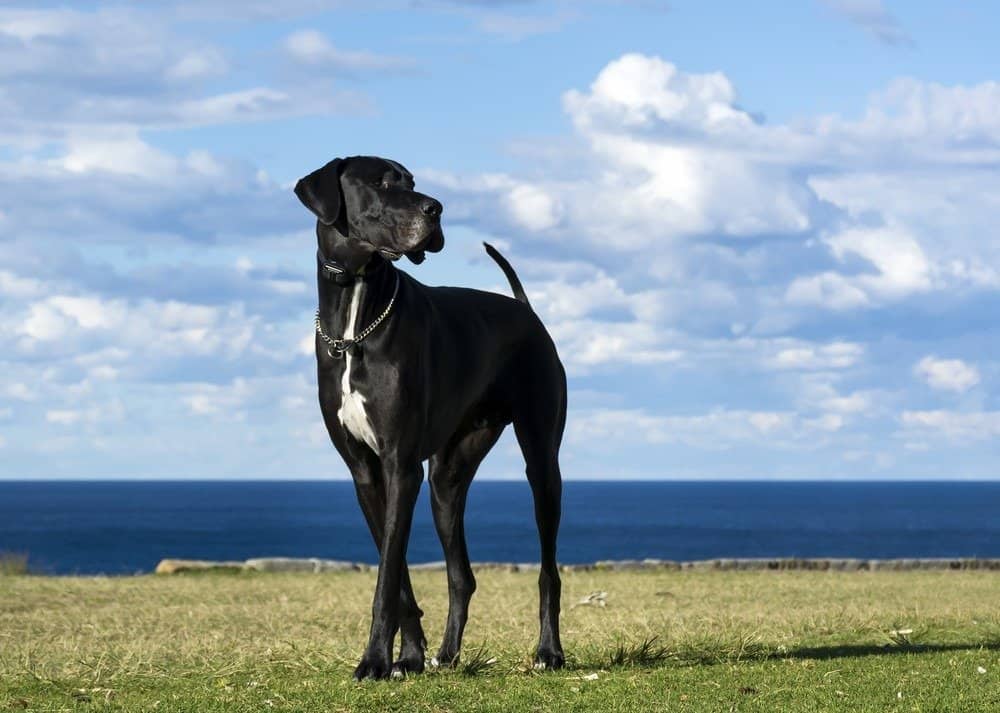The German Shepherd vs Great Dane–which of these breeds is the better fit for your family?
German Shepherds are higher energy, easier to train, and require more grooming maintenance. Great Danes are much larger, have easy to manage, short coats, and tend to take life a little less seriously than focused, driven German Shepherds.
In this article, we’ll talk about all the differences between German Shepherds and Great Danes, and whether either could be a good fit for your family.
German Shepherd vs Great Dane: A Comparison
| Key Differences | German Shepherd | Great Dane |
| Height | 22-26 inches | 28-32 inches |
| Weight | 50-90 pounds | 110-175 pounds |
| Coat | Medium-length coat | Short coat |
| Temperament | Energetic working dog | Laid-back, goofy |
| Exercise Needs | Very high | High |
| Trainability | Easy | Intermediate |
| Life Expectancy | 7-10 years | 7-10 years |
| Health Problems | Prone to bloat, elbow and hip dysplasia, degenerative myelopathy, and cardiac and eye problems | Prone to bloat, elbow and hip dysplasia, hypothyroidism, and cardiac and eye problems |
Key Differences Between Great Danes vs German Shepherds
The key differences between Great Danes and German Shepherds include their sizes, coats, temperaments, exercise needs, trainability, and health problems.
Great Danes are considered giant dogs and are much bigger than German Shepherds. German Shepherds are easier to train and require more grooming and exercise, while Great Danes are more laid-back in the home but still require plenty of daily activity.
Now, let’s look into all the differences between German Shepherds and Great Danes in more detail!

German Shepherds have mid-length fur in many colors.
©lisovyleo/Shutterstock.com
Appearance
Height
German Shepherds are smaller than Great Danes. Female Shepherds are 22-24 inches tall, while males are 24-26 inches tall.
Great Dane females stand 28-30 inches tall, while males are a whopping 30-32 inches!
German Shepherds are considered large breed dogs, while Great Danes are considered giant. Both can be difficult to handle due to their large size, especially if they pull on their leash or you need to pick them up during an emergency.
Another thing to think about before adopting a large dog is the cost of their food. Of course, it costs a lot more to feed a Great Dane than a Chihuahua!
Weight
Female Great Danes weigh 110-140 pounds. Males weigh 140-175 pounds.
German Shepherd females weigh less at 50-70 pounds, and males weigh 65-90 pounds.
Coat
Great Danes and German Shepherds also have wildly different coats! Great Danes have short fur that requires little maintenance. Brush them once a week and bathe them as needed.
German Shepherds have fluffy, mid-length fur that will take more time to brush. They might also get dirty faster than Great Danes, and shed more profusely.
German Shepherds will also have shedding seasons in the spring and fall when they blow out their undercoats. This will mean more shed fur around the house, and more grooming to be done to keep their coats healthy.
When it comes to coat color, the following are accepted by the AKC German Shepherd breed standard:
- Black
- Black and cream
- Black and red
- Black and silver
- Black and tan
- Gray
- Sable
- White
- Liver
- Blue
- Bi-color
Meanwhile, these are the colors accepted by the AKC Great Dane breed standard:
- Black
- Black and white
- Blue
- Brindle
- Fawn
- Harlequin
- Mantle
- Merle
- White
- Silver
Great Danes may also have a black mask or black or white markings throughout their bodies.

Great Danes are high-energy, but tend to relax in the home so long as they get an adequate amount of daily exercise.
©belu gheorghe/Shutterstock.com
Characteristics
Temperament
Both breeds are protective and may be wary of strangers. Socialization is important early in life so that they learn not to over-guard their people in public, and can grow into confident adult dogs.
They may also struggle to get along with other dogs. Of course, every dog is an individual–so these breeds can range from dog aggressive to friendly with most dogs. Always make introductions slowly and carefully!
A few differences between these guard dogs are that German Shepherds tend to be better with children overall, according to the American Kennel Club.
Again, each dog is an individual so this might not always hold true. No matter your dog’s breed, they should never be left unattended with children.
Great Danes also tend to be less hyper and driven when it comes to work and exercise.
Social needs
Great Danes and German Shepherds both do best in families where someone is home most of the day. No dog should be left alone for more than around four hours on a regular basis, and these breeds can be even more sensitive.
Speaking of sensitivity, Great Danes can be big babies! They may struggle in turbulent households because they feel and respond to the emotions of those around them. They’re empathetic pups.
When it comes to children and other pets, you should always be a little extra cautious introducing dogs of this size. Make introductions slowly, and never leave children and dogs unattended.
Both breeds have relatively high prey drives, with Danes being more prey driven. They might not do well with smaller pets like cats or small dogs for this reason.

As working dogs, German Shepherds need a lot of exercise and mental stimulation throughout the day.
©Dora Zett/Shutterstock.com
Exercise Needs
These are both high-energy breeds, but Great Danes tend to be calmer in the home and do require slightly less exercise.
Great Danes need a lot of daily exercise, but can be quite lazy once those needs are met. They love lounging on the couch or other cozy areas of the house.
German Shepherds were bred to work, and they’re very driven. It’s important to teach them how to relax, as this might not come naturally to them!
Of course, it’s also important to meet their need for physical exercise as well as mental stimulation. If your Shepherd is without a “job” of some sort, you might see some problematic behaviors.
Trainability
German Shepherds are typically very easy to train because they’re born people pleasers. Shepherds have been bred for a plethora of work, from police and army dogs to service dogs for disabled people.
Great Danes can be more stubborn and a little aloof. They have their own ideas and may dislike the repetition of training.
It’s best to keep training sessions short and fun. Many sessions throughout the day is better than trying to work them for an hour at a time.
I always recommend avoiding aversive techniques for all dogs and focusing on humane, science-based training methods instead. This is especially true for these breeds!
Health Factors

Great Danes and German Shepherds both have average life expectancies of 7-10 years.
©RugliG/Shutterstock.com
Life Expectancy
Both breeds have a life expectancy of 7-10 years according to the American Kennel Club.
Though giant dogs typically live shorter lives than smaller dogs like German Shepherds, German Shepherds have a fairly low lifespan for their size. This is likely due to poor breeding.
To increase your dog’s lifespan, no matter their breed, it’s important to adopt from a reputable breeder who submits and publishes all recommended health tests for their breed. You can find recommended health tests for German Shepherds and Great Danes on the OFA website.
Avoid German Shepherd show lines and opt for working lines instead. Show lines are bred to have sloped backs, which is unhealthy for the dogs’ joints.
Other ways to increase your dog’s lifespan are to feed them a quality, vet-recommended diet, provide them with plenty of daily exercise, and bring them to the veterinarian regularly.
Health Problems
Both breeds are prone to elbow and hip dysplasia, which are common in large breed dogs. They may also suffer from various cardiac and eye problems.
German Shepherd breeding lines should be tested for degenerative myelopathy, and Great Danes for hypothyroidism.
Another common ailment in these dogs is bloat, or Gastric Dilatation Volvulus (GDV). This condition is common in large, deep-chested dogs and is one of the leading causes of death in Great Danes.
It’s vital to educate yourself on bloat before adopting either of these breeds. Bloat is an emergent, life-threatening condition that 30% of dogs don’t survive, even with veterinary care.
Prevention of bloat includes providing a low-stress environment, especially around mealtimes. Feed several small meals a day in slow-feeder bowls, avoid raised bowls, and avoid exercise too soon before and after meals.
Symptoms of bloat include a swollen abdomen, abdominal pain, retching, restlessness, and excessive drooling. Dogs with bloat quickly go into shock and develop high heart rates and weak pulses. They can die within hours–so getting them to an emergency vet the moment you notice the signs is crucial.
Wrapping Up: German Shepherd vs Great Dane
When it comes down to it, both dogs can be great family dogs! It depends on your family’s lifestyle and what you want in a dog.
If you have smaller pets, you might want to choose a different breed–or go for an adult Dane or Shepherd over two years old who’s lived in a foster or previous home with similar animals.
Otherwise, German Shepherds are best for active families that want to spend a lot of time training and engaging with their dog. Great Danes are good for those who are active, but would rather go for a long walk or run and then lounge around the house resting.
The photo featured at the top of this post is ©
Thank you for reading! Have some feedback for us? Contact the AZ Animals editorial team.






